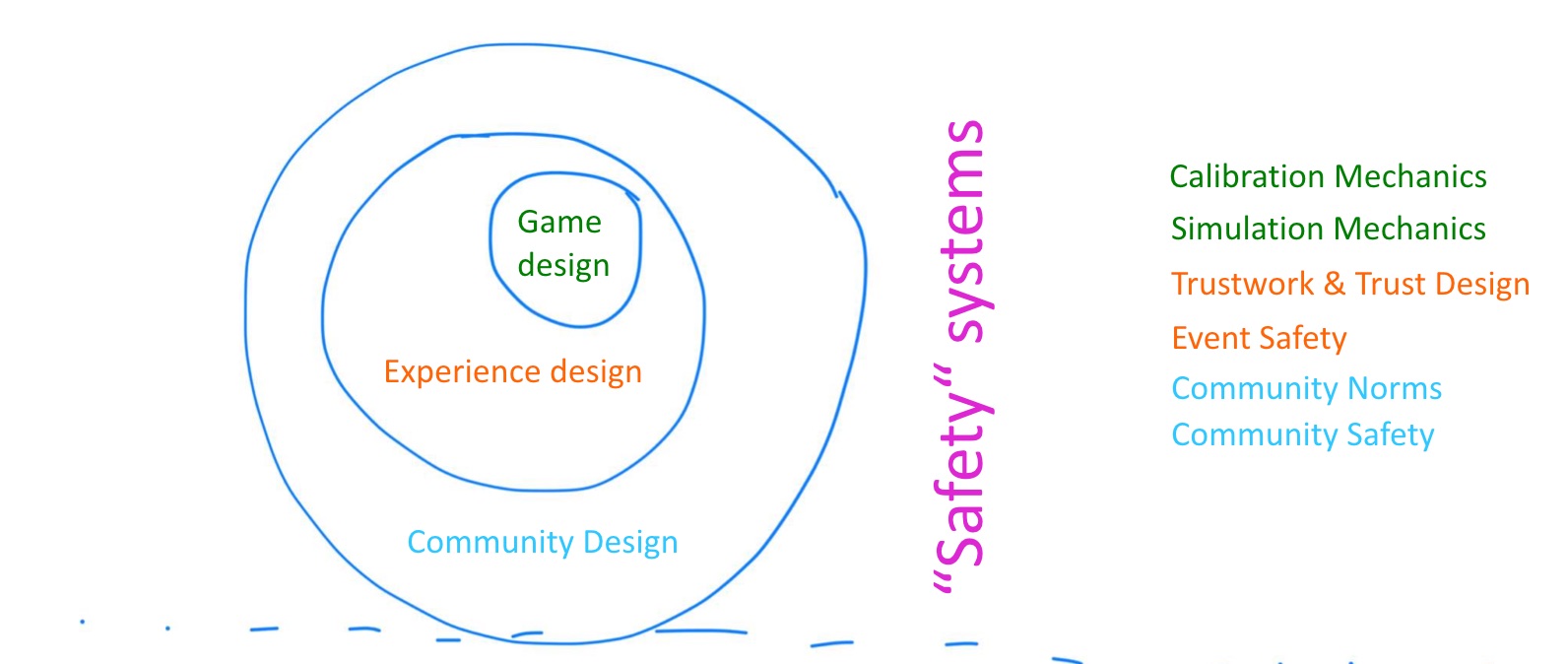In my previous post, I wrote about viewing the designable parts of your larp as not just the event’s run-time, but also pretty much everything leading up to it, and also everything that happens after, potentially for ever. (No, really).

Here are some of the things I mean in my mind when I think about larp design. (I drew the diagram with my finger again!) I’m explaining the different categories below; I’m sure there are totally more, but this is a good place to begin. Safety, trust and calibration systems goes across all of these. In the right-hand column you can see some examples of the kinds of design that is happening on each level.
Larp Design
“Larp design”, or “game design” as used in the context of larp, obviously goes beyond the design of game mechanics (which is, basically, a technical term for the “rules” of the game and the formal negotiations between players during play). Just like film or opera or videogames, larp is an art form that combines different disciplines like writing fiction, composing music, handling logistics, directing performers and so on. All of the disciplines involved interact with each other and the mechanical game design in complex ways. They are all part of the larp design, because they all have a direct relationship to the actions and experience of the players, and thus also the “outcome” of the game.
We usually use “outcome” to talk about diegetic results: what happened in the story? Did some faction reach its goals or not? But I actually also mean all of that fluffier stuff, everything that is negotiated at the end of the game – answers to questions like “did this individual player have a valuable experience”, “did the players feel the game was well designed?” or “was this larp fun?”
Because of the reasons sketched out in part 1, the outcome of the game is in great part a consequence of practices and communications that happen before the runtime, and the players’ understanding of their experience is negotiated after the runtime. Therefore those spaces are also part of larp design, whether you are making active design choices or not. (If you’re not, you are surrendering those effects entirely to the forces of tradition, assumptions and dominant norms. This is very risky unless you are designing for a community with shared assumptions who really like each other, see below).
The inclusion of pre- and postgame design also means that if you have a very conservative view of what counts as game design, you might want to add a dotted line to the diagram around the game design circle, to allow it to overlap with experience design. Don’t draw on your screen, print it out first.
Experience Design
An experience is basically a journey that a subject takes through a period of time and space that can be somehow separated from the surrounding flow of life after the fact. It typically has a narrative structure: a beginning and an end, and a middle in which something changes. Any kind of traversal of a magic circle, like a religious ritual, a sports game, a concert or a larp, can pretty much be understood as an experience. And if you think about them in an structured way like experiences, you can intentionally design them to have specific effects.

The experience design toolkit is basically exactly the same as the larp design toolkit – analyzing and/or affecting the cultures, social roles, backgrounds, and goals of the participants, and shaping the physical and social environment to produce the kinds of interactions you want. This can be done with or without storytelling techniques (although being aware of narrative arcs is always important in my opinion). And while some kind of role-taking is often involved in these spaces, they don’t necessarily involve character-play (of course, it will if the experience you’re designing is a role-playing game, kink or something like that).
In the context of larp, we can think about this as nested magic circles. One magic circle is the fiction of the game; the next one out is the formal activities before, during and after the larp; the following is the time your participants spend on location both in and out of character; the next again perhaps all of their interactions with you, your larp and the players of your larp from the first time they hear about it to the last time they think about it. You won’t design all of these limits or all of these journeys, but it’s smart to be aware of them at the very least!
Community Design
Since trust is a prerequisite of play and creativity, the underlying relations and norms of your player group will affect how they play. The obvious baseline is that people who like and trust each other to begin with, and have similar assumptions about what larps are and how to play them, are relatively easy to turn into a functioning player group for your game. If your game mixes players from different larp cultures, and/or beginners, they’ll have quite different assumptions about everything, and creating that cohesive group becomes a different process.
If approximately the same group continues playing across several games, like in a campaign larp, the player group will rapidly start thinking of itself as a community. (This might happen even before the first game they play together starts, and the culture they develop will start to form before they even physically meet). But “the community” can also be for instance the larpers of a city or region, the members of a university gaming club, the people who attend a specific convention, an extended friend group, the people who play Dystopia Rising, or (which is most common) different, fluctuating combinations of these and other communities.
But the longer one group continues to play together, the more automatic and entrenched their common assumptions will become, making it harder to on-board new players or introduce design or other structural changes. Another challenge with long-running groups is that out-of character social hierarchies also can become entrenched, and especially if they are destructive or even toxic, they will bleed into and out of the gameplay.
An aggressively socially competitive community will find playing fundamentally collaborative games very difficult, because they are unlikely to be willing to take social risks together. But in truth, they might find playing competitive games even harder, since games in which you can lose have a lot at stake.
But community design is also important for other reasons, since the community’s culture is key to things like inclusiveness, recruitment of new players, being credited for your work, organization of labour, the amounts of emotional labour required to maintain the community and so on.
The blue dotted line in the diagram is a timeline or road that represents your larp culture. You iterate your larp culture every time you organize an event for your community, and so of course do everyone else; you can only affect it in part. But hey, since you have that power wouldn’t you want your part to make your larp culture a little better?
0 thoughts on “What I Think About When I Think About Larp Design, Part II: The Disciplines”